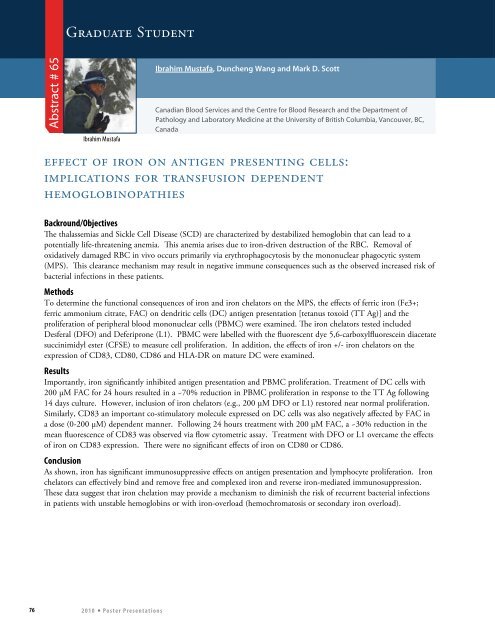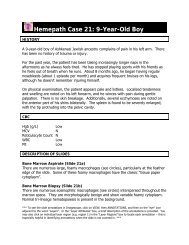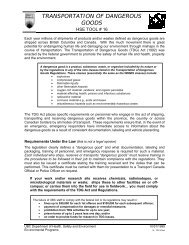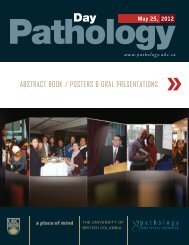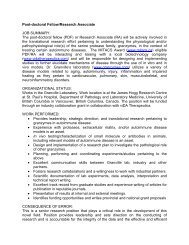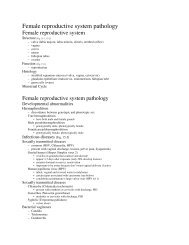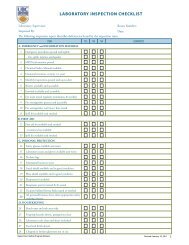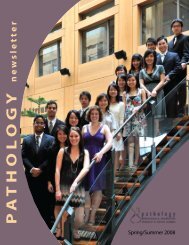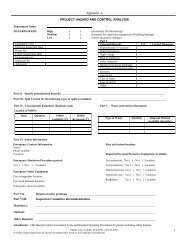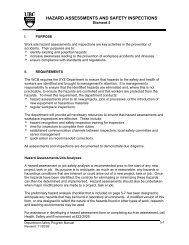Oral Presentations - Pathology and Laboratory Medicine - University ...
Oral Presentations - Pathology and Laboratory Medicine - University ...
Oral Presentations - Pathology and Laboratory Medicine - University ...
You also want an ePaper? Increase the reach of your titles
YUMPU automatically turns print PDFs into web optimized ePapers that Google loves.
Graduate StudentAbstract # 65Ibrahim MustafaIbrahim Mustafa, Duncheng Wang <strong>and</strong> Mark D. ScottCanadian Blood Services <strong>and</strong> the Centre for Blood Research <strong>and</strong> the Department of<strong>Pathology</strong> <strong>and</strong> <strong>Laboratory</strong> <strong>Medicine</strong> at the <strong>University</strong> of British Columbia, Vancouver, BC,Canadaeffect of iron on antigen presenting cells:implications for transfusion dependenthemoglobinopathiesBackround/ObjectivesThe thalassemias <strong>and</strong> Sickle Cell Disease (SCD) are characterized by destabilized hemoglobin that can lead to apotentially life-threatening anemia. This anemia arises due to iron-driven destruction of the RBC. Removal ofoxidatively damaged RBC in vivo occurs primarily via erythrophagocytosis by the mononuclear phagocytic system(MPS). This clearance mechanism may result in negative immune consequences such as the observed increased risk ofbacterial infections in these patients.MethodsTo determine the functional consequences of iron <strong>and</strong> iron chelators on the MPS, the effects of ferric iron (Fe3+;ferric ammonium citrate, FAC) on dendritic cells (DC) antigen presentation [tetanus toxoid (TT Ag)] <strong>and</strong> theproliferation of peripheral blood mononuclear cells (PBMC) were examined. The iron chelators tested includedDesferal (DFO) <strong>and</strong> Deferiprone (L1). PBMC were labelled with the fluorescent dye 5,6-carboxylfluorescein diacetatesuccinimidyl ester (CFSE) to measure cell proliferation. In addition, the effects of iron +/- iron chelators on theexpression of CD83, CD80, CD86 <strong>and</strong> HLA-DR on mature DC were examined.ResultsImportantly, iron significantly inhibited antigen presentation <strong>and</strong> PBMC proliferation. Treatment of DC cells with200 µM FAC for 24 hours resulted in a ~70% reduction in PBMC proliferation in response to the TT Ag following14 days culture. However, inclusion of iron chelators (e.g., 200 µM DFO or L1) restored near normal proliferation.Similarly, CD83 an important co-stimulatory molecule expressed on DC cells was also negatively affected by FAC ina dose (0-200 µM) dependent manner. Following 24 hours treatment with 200 µM FAC, a ~30% reduction in themean fluorescence of CD83 was observed via flow cytometric assay. Treatment with DFO or L1 overcame the effectsof iron on CD83 expression. There were no significant effects of iron on CD80 or CD86.ConclusionAs shown, iron has significant immunosuppressive effects on antigen presentation <strong>and</strong> lymphocyte proliferation. Ironchelators can effectively bind <strong>and</strong> remove free <strong>and</strong> complexed iron <strong>and</strong> reverse iron-mediated immunosuppression.These data suggest that iron chelation may provide a mechanism to diminish the risk of recurrent bacterial infectionsin patients with unstable hemoglobins or with iron-overload (hemochromatosis or secondary iron overload).76 2 0 1 0 * P o s t e r P r e s e n t a t i o n s


